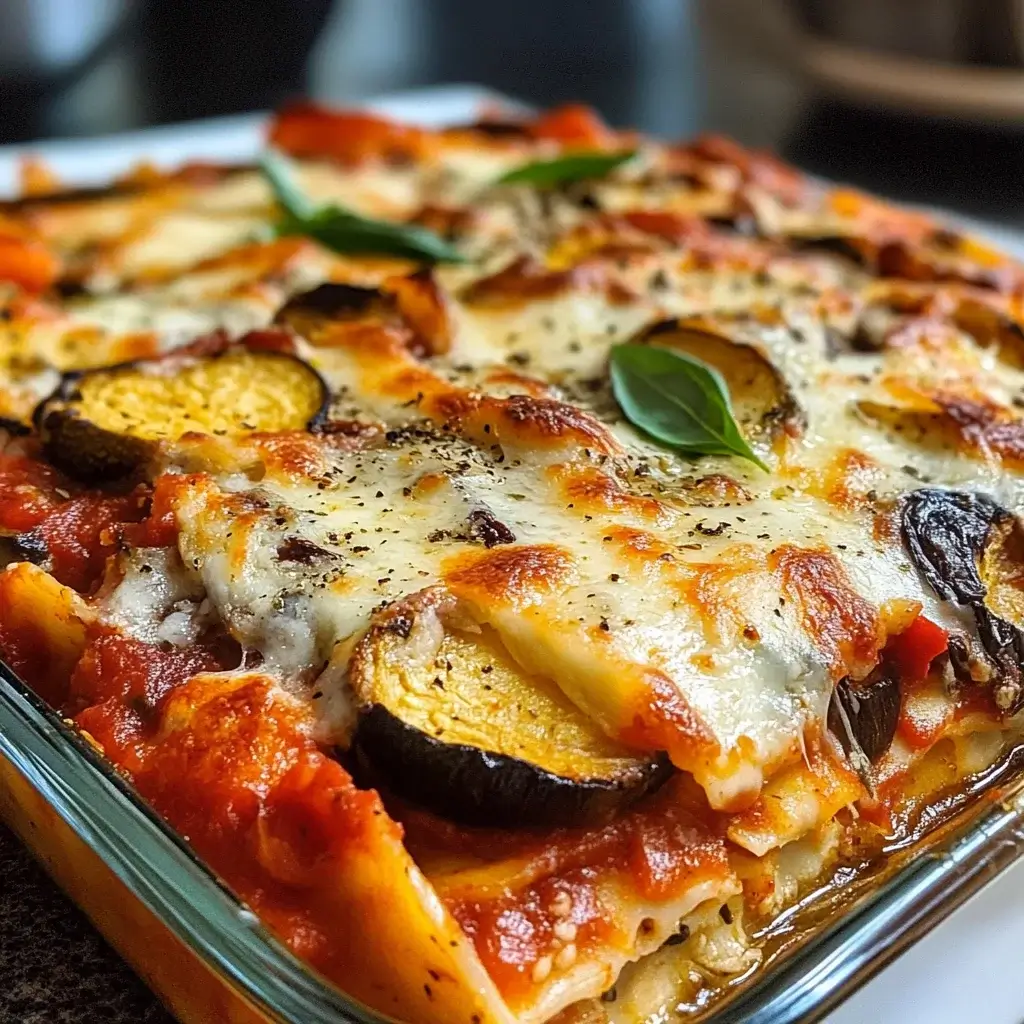There’s something truly magical about a lasagna. It’s comfort food at its finest, a dish that brings people together around the table. For years, I was intimidated by the traditional, meat-heavy versions, thinking they were too complex and frankly, not quite my style. Then I stumbled upon the beauty of roasted vegetables in lasagna. Let me tell you, it was a game-changer! This Roasted Veggie Lasagna recipe has become a staple in our home. The vibrant colors of the roasted vegetables, the creamy ricotta, and the tangy tomato sauce all meld together in perfect harmony. Even my kids, who are sometimes veggie-skeptical, devour this dish without a second thought. The roasting process brings out a natural sweetness and depth of flavor in the vegetables that you just can’t achieve any other way. It’s hearty, satisfying, and surprisingly easy to put together. Whether you’re a vegetarian, looking to incorporate more vegetables into your diet, or simply craving a delicious and comforting meal, this Roasted Veggie Lasagna is guaranteed to become a new favorite. Get ready to experience lasagna in a whole new, veggie-packed light!
Gather Your Garden: Ingredients for Roasted Veggie Lasagna
This recipe is all about fresh, vibrant vegetables. Roasting them beforehand unlocks a depth of flavor that elevates this lasagna to another level. Here’s what you’ll need to create this culinary masterpiece:
For the Roasted Vegetables:
- Eggplant: 1 large, diced into 1-inch cubes. Provides a meaty texture and absorbs flavors beautifully.
- Zucchini: 2 medium, diced into 1-inch cubes. Adds a mild sweetness and delicate texture.
- Bell Peppers: 2 (red and yellow), cored, seeded, and chopped into 1-inch pieces. Contribute sweetness and vibrant color.
- Red Onion: 1 large, cut into wedges. Roasting mellows its sharpness and brings out its sweetness.
- Mushrooms: 8 oz cremini or button mushrooms, quartered. Earthy flavor and meaty texture complement the other vegetables.
- Cherry Tomatoes: 1 pint, halved. Burst of sweetness and acidity when roasted.
- Garlic: 4 cloves, minced. Infuses aromatic flavor into the vegetables.
- Olive Oil: ¼ cup. For roasting and sautéing, adds richness and helps vegetables caramelize.
- Dried Italian Herbs: 2 teaspoons. A blend of oregano, basil, rosemary, and thyme for classic Italian flavor.
- Salt and Black Pepper: To taste. Essential for seasoning and enhancing flavors.
For the Hearty Tomato Sauce:
- Olive Oil: 2 tablespoons. For sautéing aromatics and building flavor.
- Yellow Onion: 1 medium, finely chopped. Forms the base of the sauce and adds sweetness.
- Garlic: 2 cloves, minced. Enhances the savory depth of the tomato sauce.
- Crushed Tomatoes: 28 oz can. The foundation of the sauce, choose good quality for best flavor.
- Tomato Paste: 2 tablespoons. Concentrated tomato flavor, adds richness and depth.
- Dried Oregano: 1 teaspoon. Classic Italian herb, adds warmth and aroma.
- Dried Basil: 1 teaspoon. Sweet and aromatic herb, complements tomatoes perfectly.
- Sugar: 1 teaspoon. Balances the acidity of the tomatoes and enhances sweetness.
- Salt and Black Pepper: To taste. To season and balance the sauce.
- Fresh Basil Leaves: ¼ cup, chopped (for garnish). Adds fresh, vibrant flavor at the end.
For the Creamy Ricotta Layer:
- Ricotta Cheese: 15 oz container, whole milk. Creamy base for the filling, provides richness and texture.
- Parmesan Cheese: ½ cup, grated. Adds salty, savory, and nutty notes to the ricotta layer.
- Egg: 1 large. Binds the ricotta mixture and adds richness.
- Fresh Parsley: ¼ cup, chopped. Adds freshness and herbaceous notes.
- Salt and Black Pepper: To taste. To season the ricotta mixture.
- Nutmeg: Pinch (optional). Adds a subtle warm spice that complements ricotta and cheese.
For Assembly:
- Lasagna Noodles: 9-12 oven-ready lasagna noodles (or regular noodles, cooked according to package directions). Provides the structure and layers of the lasagna.
- Mozzarella Cheese: 8 oz, shredded. Melts beautifully and creates a cheesy, gooey topping.
- Parmesan Cheese: ¼ cup, grated (for topping). Adds extra flavor and browning to the top of the lasagna.
Crafting Culinary Comfort: Step-by-Step Roasted Veggie Lasagna Instructions
Creating this Roasted Veggie Lasagna is a rewarding process, broken down into manageable steps. Roasting the vegetables is key to maximizing flavor, and the layering process is simple and satisfying. Follow these instructions to create a lasagna that will impress everyone.
Step 1: Roasting the Vegetables to Perfection
- Preheat Oven and Prepare Baking Sheet: Preheat your oven to 400°F (200°C). Line a large baking sheet with parchment paper for easy cleanup.
- Combine Vegetables: In a large bowl, combine the diced eggplant, zucchini, bell peppers, red onion wedges, quartered mushrooms, halved cherry tomatoes, and minced garlic.
- Season and Toss: Drizzle the vegetables with olive oil, sprinkle with dried Italian herbs, salt, and black pepper. Toss everything together until the vegetables are evenly coated.
- Roast the Vegetables: Spread the vegetables in a single layer on the prepared baking sheet. Roast in the preheated oven for 25-30 minutes, or until the vegetables are tender and slightly caramelized, stirring halfway through. The roasting time may vary depending on your oven and the size of the vegetable pieces. You want them to be softened and have some browned edges, indicating concentrated flavor.
- Set Aside: Once roasted, remove the vegetables from the oven and set aside to cool slightly. You can roughly chop the larger vegetable pieces if desired at this stage for easier layering.
Step 2: Simmering a Flavorful Tomato Sauce
- Sauté Aromatics: In a large saucepan or Dutch oven, heat olive oil over medium heat. Add the finely chopped yellow onion and cook until softened and translucent, about 5 minutes. Add the minced garlic and cook for another minute until fragrant, being careful not to burn the garlic.
- Build the Sauce: Pour in the crushed tomatoes and tomato paste. Stir well to combine. Add dried oregano, dried basil, sugar, salt, and black pepper.
- Simmer and Develop Flavor: Bring the sauce to a simmer, then reduce the heat to low, cover, and let it simmer for at least 20 minutes, or up to 30 minutes, stirring occasionally. Simmering allows the flavors to meld together and deepen. The longer it simmers, the richer the sauce will become.
- Taste and Adjust Seasoning: After simmering, taste the tomato sauce and adjust seasoning as needed. You might want to add more salt, pepper, sugar, or herbs to your preference.
Step 3: Preparing the Creamy Ricotta Layer
- Combine Ricotta Ingredients: In a medium bowl, combine the ricotta cheese, grated Parmesan cheese, egg, chopped fresh parsley, salt, black pepper, and a pinch of nutmeg (if using).
- Mix Until Smooth: Mix all the ingredients together until well combined and smooth. The ricotta mixture should be creamy and easily spreadable.
Step 4: Assembling the Lasagna Masterpiece
- Preheat Oven and Prepare Baking Dish: Preheat your oven to 375°F (190°C). Lightly grease a 9×13 inch baking dish.
- Layering Begins: Spread a thin layer of tomato sauce (about 1 cup) on the bottom of the prepared baking dish. This prevents the lasagna noodles from sticking and adds moisture to the bottom layer.
- Noodle Layer: Arrange a layer of lasagna noodles over the sauce, slightly overlapping if necessary to fit the dish. If using regular lasagna noodles, ensure they are cooked al dente before layering.
- Ricotta Layer: Spread half of the ricotta mixture evenly over the noodles.
- Vegetable Layer: Top the ricotta layer with half of the roasted vegetables, spreading them evenly.
- Mozzarella Layer: Sprinkle half of the shredded mozzarella cheese over the vegetables.
- Repeat Layers: Repeat layers: sauce, noodles, remaining ricotta mixture, remaining roasted vegetables, and remaining mozzarella cheese.
- Final Sauce and Cheese Topping: Top with a final layer of tomato sauce, spreading it evenly over the last layer of mozzarella. Sprinkle grated Parmesan cheese over the top for extra flavor and browning.
Step 5: Baking to Golden Brown Goodness
- Cover and Bake: Cover the baking dish tightly with aluminum foil. Bake in the preheated oven for 30 minutes. Covering with foil prevents the top from browning too quickly and allows the lasagna to heat through and the noodles to soften.
- Uncover and Brown: Remove the foil and continue to bake for another 20-25 minutes, or until the lasagna is bubbly, heated through, and the cheese is melted and golden brown on top. The baking time may vary slightly depending on your oven. You want to ensure the lasagna is heated through to the center.
- Check for Doneness: To check if the lasagna is done, insert a knife into the center; it should come out hot.
Step 6: Rest and Serve
- Rest Before Serving: Let the lasagna rest for at least 10-15 minutes before cutting and serving. This allows the lasagna to set, making it easier to slice and serve, and also prevents it from being too watery.
- Garnish and Serve: Garnish with fresh basil leaves, if desired. Cut into squares and serve hot. Enjoy the delicious symphony of flavors and textures in your Roasted Veggie Lasagna!
Nutritional Goodness: Roasted Veggie Lasagna Nutrition Facts
This Roasted Veggie Lasagna is not only delicious but also packed with nutrients from the variety of vegetables. While nutritional values can vary based on specific ingredients and serving sizes, here’s an approximate nutritional breakdown per serving (based on 8 servings):
- Serving Size: 1 slice (approximately 1/8th of the lasagna)
- Calories: Approximately 450-550 kcal
- Protein: 20-25g
Note: These values are estimates and can vary. This lasagna is a good source of vitamins, minerals, and fiber thanks to the abundance of vegetables. It’s a hearty and satisfying meal that provides a balanced combination of macronutrients.
Time to Table: Preparation and Cook Time for Roasted Veggie Lasagna
This Roasted Veggie Lasagna, while incredibly rewarding, does require some time investment. Here’s a breakdown of the time involved:
- Preparation Time: Approximately 45-60 minutes (includes vegetable chopping, roasting, sauce preparation, and ricotta mixture). Chopping vegetables is the most time-consuming part of the prep.
- Cook Time: Approximately 50-55 minutes (roasting vegetables: 25-30 minutes, baking lasagna: 50-55 minutes).
- Resting Time: 10-15 minutes (essential for lasagna to set before serving).
- Total Time: Approximately 1 hour 45 minutes to 2 hours.
While it’s not a quick weeknight meal, the hands-on time is manageable, and the results are well worth the effort. You can also break down the preparation by roasting the vegetables and making the sauce ahead of time, which significantly reduces the assembly time on the day you plan to serve it.
Serving Suggestions: Elevating Your Roasted Veggie Lasagna Experience
Roasted Veggie Lasagna is a complete meal in itself, but pairing it with complementary sides and garnishes can elevate the dining experience. Here are some serving suggestions:
- Classic Salad:
- Simple Green Salad: A light and refreshing green salad with a vinaigrette dressing provides a nice contrast to the richness of the lasagna.
- Caesar Salad: A classic Caesar salad with crisp romaine lettuce, croutons, and Parmesan cheese complements the Italian flavors of the lasagna.
- Caprese Salad: Fresh mozzarella, tomatoes, and basil drizzled with balsamic glaze offers a fresh and vibrant side.
- Bread and Garlic Goodness:
- Garlic Bread: Warm, crusty garlic bread or garlic knots are perfect for soaking up the delicious tomato sauce.
- Focaccia: Soft and flavorful focaccia bread, perhaps with rosemary or olives, is a delightful accompaniment.
- Breadsticks: Simple breadsticks provide a light and crunchy side.
- Vegetable Sides:
- Steamed or Roasted Asparagus: Lightly seasoned asparagus offers a fresh and green side dish.
- Sautéed Spinach: Simple sautéed spinach with garlic and olive oil is a quick and nutritious side.
- Roasted Broccoli: Roasted broccoli florets with a sprinkle of Parmesan cheese are a hearty and flavorful vegetable side.
- Wine Pairing:
- Chianti: A classic Italian red wine like Chianti pairs beautifully with lasagna due to its acidity and earthy notes.
- Sangiovese: Another Italian red wine, Sangiovese, offers bright fruit flavors and good acidity that complements tomato-based dishes.
- Pinot Grigio: For a white wine option, a crisp Pinot Grigio from Italy can be a refreshing choice.
- Garnishes:
- Fresh Basil: Chopped fresh basil leaves sprinkled on top add a vibrant aroma and fresh flavor.
- Parmesan Cheese: Extra grated Parmesan cheese served on the side allows guests to add more cheesy goodness to their liking.
- Red Pepper Flakes: For those who like a little heat, a sprinkle of red pepper flakes can add a subtle kick.
Pro Tips for Lasagna Perfection: Mastering Your Roasted Veggie Lasagna
To ensure your Roasted Veggie Lasagna is a resounding success, consider these helpful tips:
- Don’t Overcrowd the Roasting Pan: When roasting vegetables, ensure they are spread in a single layer on the baking sheet. Overcrowding will cause them to steam instead of roast, preventing them from caramelizing properly and developing deep flavor. Roast in batches if necessary.
- Roast Vegetables Until Tender and Slightly Browned: Roasting time can vary. Aim for vegetables that are tender but still hold their shape, with slightly browned edges. This indicates concentrated flavor.
- Use Good Quality Crushed Tomatoes: The quality of your crushed tomatoes greatly impacts the flavor of your sauce. Opt for good quality canned crushed tomatoes for the best results. San Marzano tomatoes are often recommended for their sweetness and balanced acidity.
- Simmer the Sauce for Flavor Depth: Don’t rush the sauce simmering process. Allowing the tomato sauce to simmer for at least 20-30 minutes allows the flavors to meld together and deepen, creating a richer and more complex sauce.
- Don’t Skip the Resting Time: Resting the lasagna after baking is crucial. It allows the lasagna to set, making it easier to slice and serve without falling apart. It also helps prevent it from being watery.
- Use Oven-Ready Lasagna Noodles (or Cook Regular Noodles Al Dente): Oven-ready lasagna noodles save time and simplify the process. If using regular lasagna noodles, cook them al dente according to package directions before layering to prevent them from becoming mushy in the lasagna.
- Don’t Overfill the Lasagna: Be mindful of the amount of filling in each layer. Overfilling can make the lasagna unstable and difficult to slice. Aim for even, moderate layers.
- Make Ahead for Convenience: Roasted Veggie Lasagna is a great make-ahead dish. You can assemble it entirely a day ahead of time, cover it tightly, and store it in the refrigerator. Bake it as directed, adding about 15-20 minutes to the baking time to ensure it’s heated through.
Frequently Asked Questions (FAQ) About Roasted Veggie Lasagna
Have questions about making Roasted Veggie Lasagna? Here are answers to some common queries:
Q1: Can I use different vegetables in this lasagna?
A1: Absolutely! Feel free to customize the vegetables based on your preferences and what’s in season. Other great options include butternut squash, sweet potatoes, broccoli, cauliflower, or spinach (add spinach towards the end of roasting or sauté it separately). Just ensure they are roasted or cooked appropriately before layering.
Q2: Can I make this lasagna vegan?
A2: Yes, you can easily make this lasagna vegan. Substitute the ricotta cheese with a vegan ricotta alternative (made from tofu, cashews, or almonds). Use a vegan Parmesan cheese alternative, and ensure your lasagna noodles are egg-free (most are). You can also skip the egg in the ricotta mixture or use a flax egg as a binder.
Q3: Can I make this lasagna gluten-free?
A3: Yes, simply use gluten-free lasagna noodles. Many brands offer excellent gluten-free lasagna noodle options made from rice, corn, or quinoa. Double-check all other ingredients to ensure they are gluten-free if needed.
Q4: Can I freeze Roasted Veggie Lasagna?
A4: Yes, lasagna freezes beautifully! Assemble the lasagna in a freezer-safe dish, cover tightly with plastic wrap and then foil, and freeze for up to 2-3 months. To bake from frozen, thaw overnight in the refrigerator, or bake directly from frozen (covered with foil) at 350°F (175°C) for about 1.5-2 hours, or until heated through and bubbly, removing the foil for the last 30 minutes to brown the top.
Q5: Can I use pre-made tomato sauce to save time?
A5: While homemade tomato sauce adds the best flavor, you can use a good quality pre-made marinara sauce to save time. Look for a sauce that is flavorful and not too watery. You might want to simmer it with a bit of tomato paste and herbs to enhance the flavor.
Q6: Do I need to cook the lasagna noodles before assembling?
A6: If you are using oven-ready lasagna noodles, no, you do not need to cook them beforehand. They will cook in the lasagna during baking. If you are using regular lasagna noodles, it is recommended to cook them al dente according to package directions before layering to prevent them from becoming mushy.
Q7: How long will leftover Roasted Veggie Lasagna last in the refrigerator?
A7: Leftover Roasted Veggie Lasagna can be stored in an airtight container in the refrigerator for up to 3-4 days. Reheat in the oven or microwave until heated through.
Q8: Can I add protein to this lasagna?
A8: While this is a vegetarian lasagna, you can add plant-based protein if desired. Consider adding lentils, cooked white beans (like cannellini beans), or crumbled vegetarian sausage to the vegetable mixture for an extra protein boost.

Roasted Veggie Lasagna Recipe
Ingredients
This recipe is all about fresh, vibrant vegetables. Roasting them beforehand unlocks a depth of flavor that elevates this lasagna to another level. Here’s what you’ll need to create this culinary masterpiece:
For the Roasted Vegetables:
- Eggplant: 1 large, diced into 1-inch cubes. Provides a meaty texture and absorbs flavors beautifully.
- Zucchini: 2 medium, diced into 1-inch cubes. Adds a mild sweetness and delicate texture.
- Bell Peppers: 2 (red and yellow), cored, seeded, and chopped into 1-inch pieces. Contribute sweetness and vibrant color.
- Red Onion: 1 large, cut into wedges. Roasting mellows its sharpness and brings out its sweetness.
- Mushrooms: 8 oz cremini or button mushrooms, quartered. Earthy flavor and meaty texture complement the other vegetables.
- Cherry Tomatoes: 1 pint, halved. Burst of sweetness and acidity when roasted.
- Garlic: 4 cloves, minced. Infuses aromatic flavor into the vegetables.
- Olive Oil: ¼ cup. For roasting and sautéing, adds richness and helps vegetables caramelize.
- Dried Italian Herbs: 2 teaspoons. A blend of oregano, basil, rosemary, and thyme for classic Italian flavor.
- Salt and Black Pepper: To taste. Essential for seasoning and enhancing flavors.
For the Hearty Tomato Sauce:
- Olive Oil: 2 tablespoons. For sautéing aromatics and building flavor.
- Yellow Onion: 1 medium, finely chopped. Forms the base of the sauce and adds sweetness.
- Garlic: 2 cloves, minced. Enhances the savory depth of the tomato sauce.
- Crushed Tomatoes: 28 oz can. The foundation of the sauce, choose good quality for best flavor.
- Tomato Paste: 2 tablespoons. Concentrated tomato flavor, adds richness and depth.
- Dried Oregano: 1 teaspoon. Classic Italian herb, adds warmth and aroma.
- Dried Basil: 1 teaspoon. Sweet and aromatic herb, complements tomatoes perfectly.
- Sugar: 1 teaspoon. Balances the acidity of the tomatoes and enhances sweetness.
- Salt and Black Pepper: To taste. To season and balance the sauce.
- Fresh Basil Leaves: ¼ cup, chopped (for garnish). Adds fresh, vibrant flavor at the end.
For the Creamy Ricotta Layer:
- Ricotta Cheese: 15 oz container, whole milk. Creamy base for the filling, provides richness and texture.
- Parmesan Cheese: ½ cup, grated. Adds salty, savory, and nutty notes to the ricotta layer.
- Egg: 1 large. Binds the ricotta mixture and adds richness.
- Fresh Parsley: ¼ cup, chopped. Adds freshness and herbaceous notes.
- Salt and Black Pepper: To taste. To season the ricotta mixture.
- Nutmeg: Pinch (optional). Adds a subtle warm spice that complements ricotta and cheese.
For Assembly:
- Lasagna Noodles: 9-12 oven-ready lasagna noodles (or regular noodles, cooked according to package directions). Provides the structure and layers of the lasagna.
- Mozzarella Cheese: 8 oz, shredded. Melts beautifully and creates a cheesy, gooey topping.
- Parmesan Cheese: ¼ cup, grated (for topping). Adds extra flavor and browning to the top of the lasagna.
Instructions
Creating this Roasted Veggie Lasagna is a rewarding process, broken down into manageable steps. Roasting the vegetables is key to maximizing flavor, and the layering process is simple and satisfying. Follow these instructions to create a lasagna that will impress everyone.
Step 1: Roasting the Vegetables to Perfection
- Preheat Oven and Prepare Baking Sheet: Preheat your oven to 400°F (200°C). Line a large baking sheet with parchment paper for easy cleanup.
- Combine Vegetables: In a large bowl, combine the diced eggplant, zucchini, bell peppers, red onion wedges, quartered mushrooms, halved cherry tomatoes, and minced garlic.
- Season and Toss: Drizzle the vegetables with olive oil, sprinkle with dried Italian herbs, salt, and black pepper. Toss everything together until the vegetables are evenly coated.
- Roast the Vegetables: Spread the vegetables in a single layer on the prepared baking sheet. Roast in the preheated oven for 25-30 minutes, or until the vegetables are tender and slightly caramelized, stirring halfway through. The roasting time may vary depending on your oven and the size of the vegetable pieces. You want them to be softened and have some browned edges, indicating concentrated flavor.
- Set Aside: Once roasted, remove the vegetables from the oven and set aside to cool slightly. You can roughly chop the larger vegetable pieces if desired at this stage for easier layering.
Step 2: Simmering a Flavorful Tomato Sauce
- Sauté Aromatics: In a large saucepan or Dutch oven, heat olive oil over medium heat. Add the finely chopped yellow onion and cook until softened and translucent, about 5 minutes. Add the minced garlic and cook for another minute until fragrant, being careful not to burn the garlic.
- Build the Sauce: Pour in the crushed tomatoes and tomato paste. Stir well to combine. Add dried oregano, dried basil, sugar, salt, and black pepper.
- Simmer and Develop Flavor: Bring the sauce to a simmer, then reduce the heat to low, cover, and let it simmer for at least 20 minutes, or up to 30 minutes, stirring occasionally. Simmering allows the flavors to meld together and deepen. The longer it simmers, the richer the sauce will become.
- Taste and Adjust Seasoning: After simmering, taste the tomato sauce and adjust seasoning as needed. You might want to add more salt, pepper, sugar, or herbs to your preference.
Step 3: Preparing the Creamy Ricotta Layer
- Combine Ricotta Ingredients: In a medium bowl, combine the ricotta cheese, grated Parmesan cheese, egg, chopped fresh parsley, salt, black pepper, and a pinch of nutmeg (if using).
- Mix Until Smooth: Mix all the ingredients together until well combined and smooth. The ricotta mixture should be creamy and easily spreadable.
Step 4: Assembling the Lasagna Masterpiece
- Preheat Oven and Prepare Baking Dish: Preheat your oven to 375°F (190°C). Lightly grease a 9×13 inch baking dish.
- Layering Begins: Spread a thin layer of tomato sauce (about 1 cup) on the bottom of the prepared baking dish. This prevents the lasagna noodles from sticking and adds moisture to the bottom layer.
- Noodle Layer: Arrange a layer of lasagna noodles over the sauce, slightly overlapping if necessary to fit the dish. If using regular lasagna noodles, ensure they are cooked al dente before layering.
- Ricotta Layer: Spread half of the ricotta mixture evenly over the noodles.
- Vegetable Layer: Top the ricotta layer with half of the roasted vegetables, spreading them evenly.
- Mozzarella Layer: Sprinkle half of the shredded mozzarella cheese over the vegetables.
- Repeat Layers: Repeat layers: sauce, noodles, remaining ricotta mixture, remaining roasted vegetables, and remaining mozzarella cheese.
- Final Sauce and Cheese Topping: Top with a final layer of tomato sauce, spreading it evenly over the last layer of mozzarella. Sprinkle grated Parmesan cheese over the top for extra flavor and browning.
Step 5: Baking to Golden Brown Goodness
- Cover and Bake: Cover the baking dish tightly with aluminum foil. Bake in the preheated oven for 30 minutes. Covering with foil prevents the top from browning too quickly and allows the lasagna to heat through and the noodles to soften.
- Uncover and Brown: Remove the foil and continue to bake for another 20-25 minutes, or until the lasagna is bubbly, heated through, and the cheese is melted and golden brown on top. The baking time may vary slightly depending on your oven. You want to ensure the lasagna is heated through to the center.
- Check for Doneness: To check if the lasagna is done, insert a knife into the center; it should come out hot.
Step 6: Rest and Serve
- Rest Before Serving: Let the lasagna rest for at least 10-15 minutes before cutting and serving. This allows the lasagna to set, making it easier to slice and serve, and also prevents it from being too watery.
- Garnish and Serve: Garnish with fresh basil leaves, if desired. Cut into squares and serve hot. Enjoy the delicious symphony of flavors and textures in your Roasted Veggie Lasagna!
Nutrition
- Serving Size: one normal portion
- Calories: 550
- Protein: 25g






